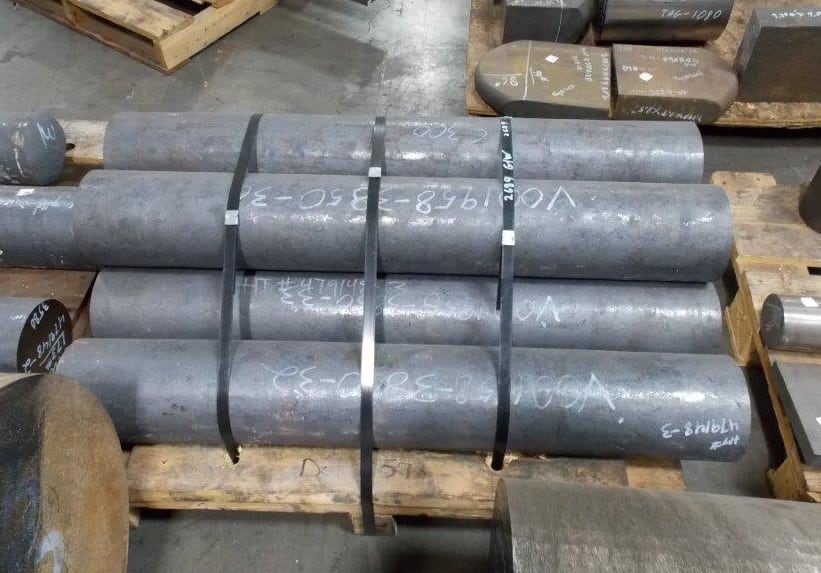Ti-6Al-4V titanium alloy (also known as Titanium 6-4 and Grade 5 titanium) is the most commonly used alpha-beta alloy due to an outstanding strength to weight ratio, ability to withstand extreme temperatures, excellent corrosion resistance, and impressive welding and fabrication ability. This makes Ti 6-4 extremely versatile in a number of markets and application including the industrial, aerospace, military, and automotive spaces.
At Rickard Specialty Metals, we have 30+ years as a Ti-6Al-4V supplier of forgings, plates, sheets and more to your custom measurements and shapes. Our forging process includes open die forgings, ring rolling and more. See below for a list of common forged shapes we supply, including Ti 6Al-4v round bar and flat bar.
NOMINAL COMPOSITION
- Al 5.5 – 6.75
- V 3.5 – 4.5
- Fe .03 max
- C .08 max
- N .05 max
- H .0125 max
- O .2 max
- Y .005 max
- Ti Balance
- Remainder Each .1 max
- Remainder Total .4 max
STANDARD SPECIFICATIONS
- AMS 4911
- AMS 4920
- AMS 4928
- AMS 4934
- AMS 4935
- AMS 4965
- AMS 4967
- AMS 6930
- AMS 6931
- ASTM B 265
- ASTM F 136
- MIL-T-9046
- MIL-T-9047
- ASTM B348
- AMS-T-9046
- ASTM B381
- ASTM B265
- MMS-1233
- MMS-1217
- DMS-2285
- DMS-1583
- DMS-2442 R-1
- DMS-1592
- DMS-1570
- BMS 7-348
- UNS R56400
6-4 TITANIUM FORGINGS
- Round Bar
- Flat Bar
- Rectangular Bar
- Rolled Rings
- Forged Rings
- Disc
OTHER PRODUCT FORMS
- Sheet
- Plate
- Extrusion
- Extrusion angles
- Billet
- Ingot
- Machined Parts
Ti-6Al-4V Additional Information:
Physical Properties
Hardness: HRC 39 max, typical HRC 34-36.
Density: 0.161 lbs/cubic inch
Modulus of Elasticity: 16.5 msi
Coefficient of Expansion: 5.11 microinch/inch/degree F from RT to 600F
Machining
Machining rating for Ti 6al-4v (based on AISI AISI B1112) is 22%. Typically, low cutting speeds, heavy feed rates and copious amounts of cutting fluid are recommended. Additionally, chlorinated cutting fluids should be avoided to prevent contamination.
Welding
The welding ability of 6Al-4V is good in normal conditions. When welding be sure to use inert gas shielding and post weld thermal processing is recommended. When performing fusion welding we also recommend using a weld filler.
Forming
Forming is difficult to perform with Titanium 6-4. For severe forming conditions it is recommended to perform forming at elevated temperatures.
Corrosion Resistance
6Al-4V generally has excellent resistance to corrosion, although, the alloy is sometimes susceptible to hot salt stress corrosion cracking. This risk can be minimized with proper processing.
Heat Treatment
Heat treatment for Ti-6Al-4V is most commonly used in the annealed condition. This is due to limited section size hardenability of the metal. For those looking to improve tensile properties we recommend performing a solution heat treatment followed by aging. Increased strength is also possible through heat treatment, however, it is gained at the expense of fracture toughness.
When annealing it is recommended to use general purpose Mill Anneal (MA). One should be aware that this may not result in a full anneal, and there may be traces of hot, cold or warm working in heavily worked products such as sheet. Duplex anneal and triplex annealing can be used for improved creep resistance. Recrystallization anneal (RA) and beta anneal (BA) are used to improve fracture toughness. Lastly, Beta annealing should be done above the beta transus temperature.
When performing precipitation hardening, one may use solution treatment and aging (STA) for a wide range of strength levels and ductility. This range will differ depending on the STA cycle and the section size. Additionally, solution treatment and overaging (STOA) can be employed to increase strength, toughness and dimensional stability.
Forging
Typically forging for 6Al-4v is done in the alpha-beta region (1600F-1800F) to impart a mixed mode microstructure (primary alpha and transformed beta phases). Finished forgings should have all alpha case (hard, brittle, oxygen enriched layer) removed prior to usage and heat treated via one of the methods mentioned in the heat treatment section above prior to usage.
6AL-4V Titanium Mechanical Properties for AMS4928
MINIMUM TENSILE VALUES, INCH/POUND UNITS
| Nominal Diameter of Distance Between Parallel Sides (Inches) | Tensile Strength ksi |
Yield Strength at 0.2% Offset ksi |
Elongation in 4D % Long. |
Elongation in 4D % L.T. |
Elongation in 4D % S.T. |
Reduction of Area % Long. |
Reduction of Area % L.T. |
Reduction of Area % S.T. |
| Up to 2.000, incl | 135 | 125 | 10 | 10 | — | 25 | 20 | — |
| Over 2.000 to 4.000, incl | 130 | 120 | 10 | 10 | 10 | 25 | 20 | 15 |
| Over 4.000 to 6.000, incl | 130 | 120 | 10 | 10 | 8 | 20 | 20 | 15 |
MINIMUM TENSILE VALUES, SI UNITS
| Nominal Diameter of Distance Between Parallel Sides (Millimeters) | Tensile Strength MPa |
Yield Strength at 0.2% Offset MPa |
Elongation in 4D % Long. |
Elongation in 4D % L.T. |
Elongation in 4D % S.T. |
Reduction of Area % Long. |
Reduction of Area % L.T. |
Reduction of Area % S.T. |
| Up to 50.80, incl | 931 | 862 | 10 | 10 | — | 25 | 20 | — |
| Over 50.80 to 101.60, incl | 896 | 827 | 10 | 10 | 10 | 25 | 20 | 15 |
| Over 101.60 to 152.40, incl | 896 | 827 | 10 | 10 | 8 | 20 | 20 | 15 |

